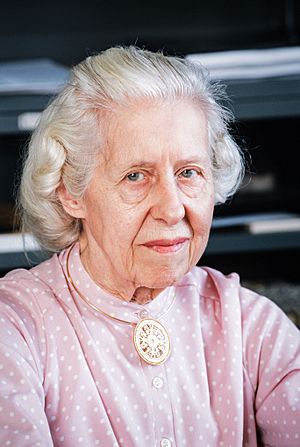Betty Meggers facts for kids
Quick facts for kids
Betty Meggers
|
|
|---|---|

Meggers in 2000
|
|
| Born | December 5, 1921 |
| Died | July 2, 2012 (aged 90) |
| Alma mater | University of Pennsylvania, University of Michigan, Columbia University |
| Scientific career | |
| Fields | Anthropology in South America |
| Institutions | National Museum of Natural History, Smithsonian Institution |
Betty Jane Meggers (December 5, 1921 – July 2, 2012) was an American archaeologist. She was famous for her work in South America. Betty Meggers was an important researcher at the Smithsonian Institution. She wrote a lot about how the environment shapes human cultures.
Contents
Who Was Betty Meggers?
Betty Jane Meggers was born in Washington, D.C. Her parents were Dr. William Frederick Meggers and Edith R. Meggers. Her father was a well-known scientist who studied light. He also loved archaeology. He often took his family to visit ancient Native American sites. This sparked Betty's interest in the past.
Her Education Journey
Betty Meggers went to the University of Pennsylvania. She earned her first degree there in 1943. A year later, she got her master's degree from the University of Michigan.
After that, Meggers studied at Columbia University. She earned her Ph.D. in 1952. Her main research was about the ancient Marajoara culture in Brazil.
While at Columbia, she met Clifford Evans. He was also an archaeology student. They got married on September 13, 1946. Betty Meggers passed away on July 2, 2012, after a long career.
Exploring Ancient Cultures
Most of Betty Meggers's research focused on South America. She worked in countries like Ecuador, Peru, and Brazil. She also explored islands in the Caribbean and Micronesia.
Early Discoveries
When she was just 16, Betty started volunteering. She worked at the Smithsonian Institution. She helped put together broken pots from Pueblo Bonito. This was an ancient village in New Mexico.
At the University of Michigan, she learned about old pottery. This pottery came from Marajó Island in the Amazon basin. She wrote her first science article about the Marajoara culture in 1945.
The Environment's Role
In 1954, Meggers shared an idea. She suggested that the environment limits how complex a society can become. She believed that the amount of food and resources available affected cultures.
Because of this idea, Meggers thought early cultures did not start in the Amazon basin. She believed people moved there from highland areas. However, new discoveries have started to change these ideas.
Pottery Puzzles
In the 1960s, Meggers and Evans had a debated theory. They noticed similarities between pottery from Ecuador and Japan. The pottery from the Valdivia culture in Ecuador was very old. It looked like pottery from the Jōmon period in Japan.
Meggers thought people from Japan might have traveled across the Pacific Ocean. She believed they brought their pottery skills to Ecuador. She also noted that some plants and diseases found in the Andes came from Japan.
Other archaeologists questioned this idea. The distance between Ecuador and Japan is huge. There was also little proof of advanced Japanese sailing. Later discoveries showed that pottery in Ecuador was even older. Most archaeologists now think pottery developed separately in these places.
Meggers and Evans also created a way to study pottery pieces. Betty Meggers was one of the first to look at how the environment affects ancient societies. She saw culture as a way humans adapt to their surroundings.
Working with Others
Betty Meggers was part of many important groups.
- 1950-1951: She taught at the American University in Washington, D.C.
- Since 1954: She was a research associate at the Smithsonian Institution.
- 1959-1961: She was the Executive Secretary for the American Anthropological Association.
At the time of her death in 2012, she held key roles. She was a lead researcher for a program in the Amazon. She also directed the Latin American Archaeology Program at the Smithsonian.
Awards and Recognition
Betty Meggers received many awards. These awards recognized her work in archaeology and South American studies.
- 1956: Washington Academy of Sciences Award for Scientific Achievement
- 1966: Decoration of Merit from the Government of Ecuador
- 1966: Gold Medal from the 37th International Congress of Americanists
- 1985: Society for American Archaeology, 50th Anniversary Award
- 1997: Medalla de "La Periquera" from the Museo Provincial de Holgun, Cuba
- 1997: Doctor Honoris Causa from the Universidad Nacional de la Plata, Argentina
- 1998: Meggers & Evans were honored by the Embassy of Ecuador for their contributions.
See also
 In Spanish: Betty Meggers para niños
In Spanish: Betty Meggers para niños

